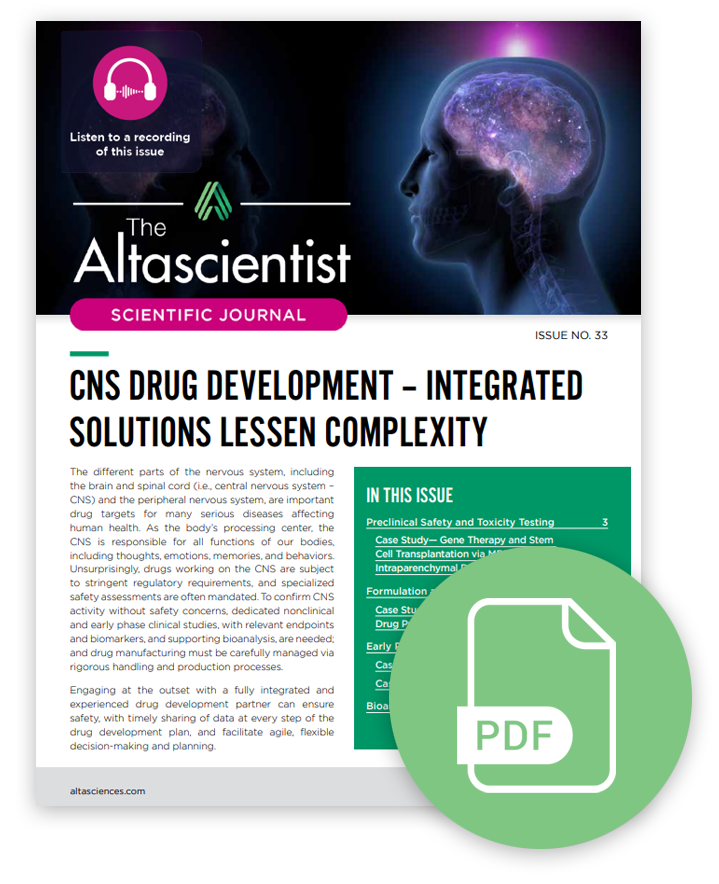ISSUE NO. 33 — End-to-End CNS Drug Development Solutions

In Issue 33 of The Altascientist, we explore how a comprehensive, end-to-end integrated approach to drug development for central nervous system (CNS) therapeutics can take you seamlessly from lead candidate selection to market.
Engaging at the outset with a fully integrated and experienced drug development partner can ensure safety, with timely data sharing at every step of the drug development plan, and facilitate agile, flexible decision-making and planning.
With detailed case studies, study considerations, and more, this Issue covers:
- preclinical safety and toxicity testing,
- formulation and manufacturing,
- early-phase clinical trials, and
- bioanalysis.
the cns drug development landscape
The different parts of the nervous system, including the brain and spinal cord (i.e., central nervous system – CNS) and the peripheral nervous system, are important drug targets for many serious diseases affecting human health. As the body’s processing center, the CNS is responsible for all functions of our bodies, including thoughts, emotions, memories, and behaviors.
The global market for CNS therapeutics is a multi-billion-dollar industry and is projected to grow from $102.4 billion USD in 2023 to $166.53 billion USD by 2028. This growth is driven primarily by the rising demand for age-related neurodegenerative treatments due to the increasing global population over the age of 65, the growing potential of psychedelic therapies in treating conditions like PTSD and psychosis, and CNS-active drugs proving increasingly effective across various areas, such as acute and chronic pain, brain diseases, and autoimmune disorders.
“The successful delivery of drugs targeting the treatment of CNS conditions is challenged by the blood-brain barrier (BBB) and blood-cerebrospinal fluid barrier (BSCFB), which protect the CNS from intrusion by harmful substances. Large molecules are less able to penetrate the blood/brain barrier to deliver therapeutic results and thus most CNS-active drugs are small molecules.” — The Altascientist, Issue 33, pg. 2.
SPECIALIZED ASSESSMENTS AND STUDIES
Unsurprisingly, drugs working on the CNS are subject to stringent regulatory requirements, and specialized safety assessments are often mandated. To confirm CNS activity without safety concerns, dedicated nonclinical and early-phase clinical studies, with relevant endpoints and biomarkers and supporting bioanalysis, are needed, and drug manufacturing must be carefully managed via rigorous handling and production processes.
“Specialized assessments in nerve conduction are sometimes performed in CNS drug development, depending on the specifics of the new molecular entities. These key assays, performed in NHPs, can be included in preclinical safety and toxicology programs to assess the peripheral neuropathy (PN) liability of a new drug.” — The Altascientist, Issue 33 pg. 5.
The many advancements in developing CNS-active drugs have been hampered by higher failure rates compared to drug discovery in most other therapeutic domains. Identifying CNS experts with a well-established record of conducting rigorous, high-quality research can assure the effective management of challenges and reduce the risks of delaying or failing to advance promising drug candidates.
Explore all issues of The Altascientist in our Resource Center. And don’t forget to subscribe to “The Altascientist: Audiobooks” on Spotify, Apple Podcasts, or wherever you get your audio content.